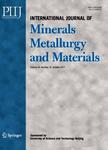Microstructure evolution and phase transformation of traditional cast and spray-formed hypereutectic aluminium-silicon alloys induced by heat treatment
Microstructure evolution and phase transformation of traditional cast and spray-formed hypereutectic aluminium-silicon alloys induced by heat treatment作者机构:State Key Laboratory for Advanced Metals and Materials University of Science and Technology Beijing Beijing 100083 China School of Materials Science and Engineering University of Science and Technology Beijing Beijing 100083 China
出 版 物:《International Journal of Minerals,Metallurgy and Materials》 (矿物冶金与材料学报(英文版))
年 卷 期:2010年第17卷第3期
页 面:297-306页
核心收录:
学科分类:08[工学] 080502[工学-材料学] 0805[工学-材料科学与工程(可授工学、理学学位)]
基 金:supported by the Major State Basic Research & Development Program of China (No2006CB605204)
主 题:hypereutectic Al-Si alloy spray forming cast microstructure phase transformation
摘 要:Microstructural evolution and phase transformation induced by different heat treatments of the hypereutectic aluminium-silicon alloy, Al-25Si-5Fe-3Cu (wt%, signed as 3C), fabricated by traditional cast (TC) and spray forming (SF) processes, were investigated by differential scanning calorimetry (DSC) and scanning electron microscopy (SEM) combined with energy dispersive X-ray spectroscopy and X-ray diffraction techniques. The results show that A17Cu2Fe phase can be formed and transformed in TC- and SF-3C alloys between 802-813 K and 800-815 K, respectively. The transformation from β-Al5FeSi to δ-Al4FeSi2 phase via peritectic reaction can occur at around 858-870 K and 876-890 K in TC- and SF-3C alloys, respectively. The starting precipitation temperature of δ-Al4FeSi2 phase as the dominant Fe-bearing phase in the TC-3C alloy is 997 K and the exothermic peak about the peritectic transformation of δ-Al4FeSi2→β-Al5FeSi is not detected in the present DSC experiments. Also, the mechanisms of the microstructural evolution and phase transformation are discussed.



